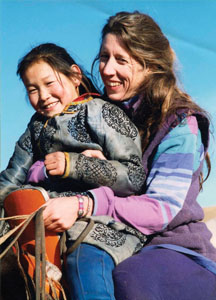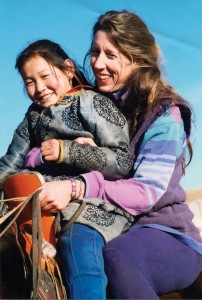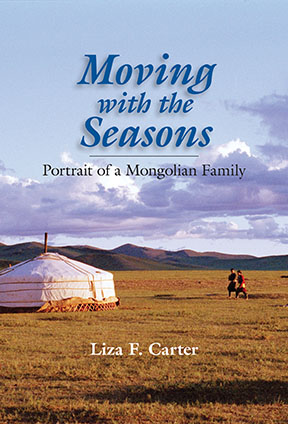BETWEEN THE LINES

In Moving with the Seasons: Portrait of a Mongolian Family (Saltwind Press, 2014) Liza F. Carter ’79 offers an illuminating tribute to a nomadic pastoral lifestyle in contemporary times.
When I tell people that I wrote a book on Mongolian nomads, the first thing out of their mouths is always a variant of “Mongolia! What took you to Mongolia?” The answer is simple: camels. At least, that’s what took me there the first time. An environmental scientist by training, I first visited Mongolia in 1997 as part of a scientific expedition assessing the feasibility of studying the highly endangered population of wild Bactrian two-humped camels living in the Gobi desert.
On returning home after that first visit, I realized that while I had gone to find Mongolian camels, I had been captivated by the Mongolian people. The nomadic herders, who had comparatively few material possessions yet were so welcoming to complete strangers, intrigued me. I couldn’t help contrasting what I had experienced in Mongolia with life in the United States, where people have so much stuff yet frequently feel disconnected and lonely.
During the months following my first visit to Mongolia, I discovered I couldn’t shake the images in my mind of the nomadic herders’ lives. As I went through my daily tasks—taking care of children, cooking, fixing things in the house, patching clothes, and feeding my animals—I kept wondering about how these activities work in a small moveable tent with a flock of animals that numbered in the hundreds. Realizing that I knew next-to-nothing about the daily life of Mongolian nomads, I spent time in the nearby anthropology library at Harvard trying to learn all I could about Mongolian nomads. To my surprise, I discovered there was practically nothing in print! I went through journal after journal and found just a few academic articles written before 1921, when the Soviets took over Mongolia. Cut off from all access to the West, Mongolia became the first Soviet satellite state.
On one frigidly cold day amidst the jumble of domestic life with small children after the umpteenth time of wrangling snowsuits and boots on and off, I sat down in front of my computer, cup of tea in hand. I found myself flooded with memories of Mongolia. I remembered first the beauty of the country, how it impressed me visually, from the landscape to the people and their clothing. Mongolian people dress in vibrant colors: blues, purples, greens, and reds. As a visual artist, I experience the world through images. And I saw it all again in my mind’s eye. There were the enormous wide-open spaces of rolling grassland steppe in shades of light green and brown highlighted with bursts of color, a few white tents called gers (known in the West as yurts), and the colorful dress. I recalled the delight of being so welcomed by total strangers on the opposite side of the globe. That was the moment when the idea of a photography book about Mongolia’s nomadic herders emerged.
Looking back, I now understand that a strong part of my desire to write this book was a desire to immerse myself into that world of welcome. I had fallen in love with the landscape, but the people utterly captivated me. In a mere five minutes, the book project burbled up from my unconscious. Over the 16-year arc of this work, I was driven by my desire to document the Mongolian nomad’s way of life before it was obliterated by the modern world.

As an independent artist and researcher, my first challenge was to figure out how to fund the research. My solution was to start a small adventure travel business that led trips to Mongolia and provided me with an income. I was one of the first tour operators taking visitors to Mongolia. What distinguished my trips was a deep focus on exploring the cultural and natural history of this remarkable country.
My book draws on my intimate experience with a single family living on the steppe to reveal the unique culture of Mongolian nomads and their remarkable capacity to thrive in one of the world’s harshest environments before that culture disappears. The book was a collaborative effort between myself and the wonderful nomadic Mongolian family who welcomed me into their lives.
The family turned out to be an ideal family for my book project in ways I couldn’t have predicted. Curious about other parts of the world, they were also eager to share their lives so that others might learn about Mongolia. I was delighted by their warmth and openness as I asked all sorts of questions and took thousands of pictures. Naturally, curiosity is a two-way street. Body hair was one of the first topics. There is nothing like being surrounded by a group of fascinated kids who are all inspecting the hair on your arms by pulling it. It drove home the point that Mongolians have little or no body hair, unlike Caucasians.
I made four trips to visit the family over a period of three years—including one winter trip. After these four trips, I had, on one level, all the information and photographs I needed to write the book, yet the truth was that I was not ready. It took me four more years to absorb the lessons the Mongolians taught me. Marcel Proust wrote that “the voyage of discovery lies not in finding new landscapes, but in having new eyes.” While in Mongolia, I certainly explored new landscapes, but more importantly, I discovered new ways of seeing and being. Spending time with my Mongolian family recalibrated my internal scale of what I needed to have a happy life in the United States.
Liza F. Carter is a photographer of indigenous cultures and peoples. Her goal is to share unknown worlds and provide levels of understanding of other cultures that are more than just sound bites or sensationalism. She has a BA in earth and environmental sciences from Wesleyan and an MA in forestry and environmental studies from Yale University. As a thank-you to the nomadic family who were her collaborators, 50 percent of the profits from her new book will be going to support health care for nomadic Mongolian children.


